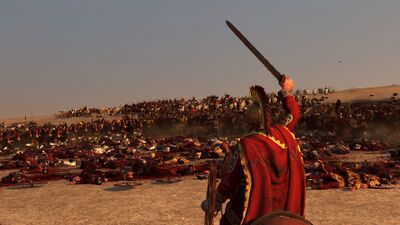Symmerian-Hannashka Wars: Difference between revisions
No edit summary |
No edit summary |
||
| Line 24: | Line 24: | ||
| combatant3 = | | combatant3 = | ||
| commander1 = {{flagicon image|MakedonFlag.png|22px}} Anaxandridas | | commander1 = {{flagicon image|MakedonFlag.png|22px}} Anaxandridas | ||
| commander2 = Kamadyu the Magnificent | | commander2 = [[Kamadyu the Magnificent]] | ||
| units1 = [[Ancient Makedonian army]] | | units1 = [[Ancient Makedonian army]] | ||
| units2 = Hannashka military | | units2 = Hannashka military | ||
Revision as of 22:16, 9 October 2021
| Makedonian-Hannashka Wars | |||||||
|---|---|---|---|---|---|---|---|
 A Makedonian Strategos urges his troops on | |||||||
| |||||||
| Belligerents | |||||||
|
|
| ||||||
| Commanders and leaders | |||||||
|
| Kamadyu the Magnificent | ||||||
| Units involved | |||||||
| Ancient Makedonian army | Hannashka military | ||||||
| Strength | |||||||
| Hundreds of thousands | Hundreds of thousands | ||||||
| Casualties and losses | |||||||
| Heavy | Heavy | ||||||
The Makedonian-Hannashka Wars were a series of conflicts between the Makedonian Empire and the Hannashka Empire fought from 151 to 366 CE. The wars would be an off-on affair for the btter part of three centuries, ultimatley concluded in a lasting peace in 366 CE, just three decades prior the collapse of the Hannashka Empire. The wars were fought concurrently with the Discovery Wars between Makedon and Serikos, and although events in one conflict often influenced the other, they are considered separate wars.
The origin of the wars laid in the Makedonian conquest of Mansuriyyah and subsequent victory against the Seyhad League during the Seyhad Wars. Although the Makedonians had maintained peaceful relations with the Chalna Empire, Makedonian expansionism into Nalaya and Khatlia brought the Empire into contact with the Hannashka, whom themselves had conquered the Indo-Hellenic Kingdom of Arosiananda. Tensions between the two powers focused heavily on control of northern Nalaya, southern Mansuriyyah, and Mavamahar. The rugged terrain of much of south-west Siduri helped lead to numerous border conflicts throughout the 2nd Century, before escalating into open warfare in the 3rd Century.Both sides fielded and mobilized massive armies drawn up from their vast territories. The wars were in many ways a clash of different styles of warfare; the Hannashka military was dominated by heavy cavalry and horse archers while the Makedonians relied on their pikes and heavy infantry. Both sides made extensive usage of levy troops from their satrapies and merecenaries; some tribes, like the Khiyzan, served on both sides over the course of the wars.
The Makedonians initially enjoyed considerable successs against the Hannashka. By 250 CE the Makedonians had driven the Hannashka armies from Makedonian Mansuriyyah entirely, and had invaded Khatlia, including Mavamahar, Gahlighan, and had raided into Ganjarejan. The ascension of Kamadyu the Magnificent to the Hannashka throne in the latter half of the 2nd Century marked a turning point in the conflict; by 300 CE the Hannashka had reconquered eastern Mansuriyyah and driven the Makedonians almost entirely from Khatlia. The Makedonians would continue to lose ground in Nalaya throughout the 4th Century and by 400 CE only a few coastal holdouts remained. Hannashka hopes to drive the Makedonians from Mansuriyyah entirely were undermined by logistical difficulties of supporting an army across the Sahrat al-kabir desert and the closer proximity to Makedonian bastions in Ruvelka and Syara.
The final battles between the two empires were fought in 366 CE, after which a tenuous peace was achieved. Success against the Makedonians ultimately left the Hannashka too depleted to stop the rise of the Rideva Empire which steadily conquered Hannashka territory before the empire collapsed in 393 CE, bringing an end to the wars with Makedon. Most of Mansuriyyah and parts of Nalaya were subsequently reconquered by the Makedonians under Alexarchus in the mid-5th Century.